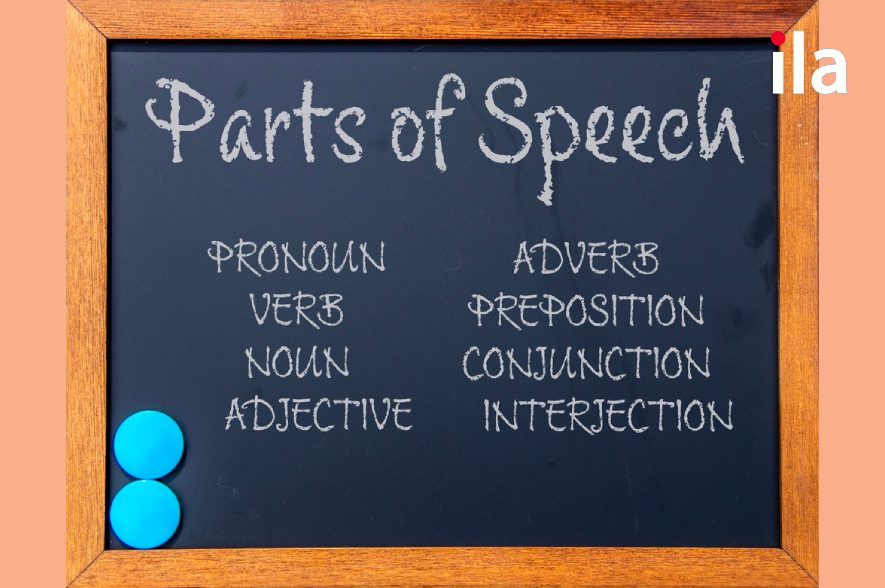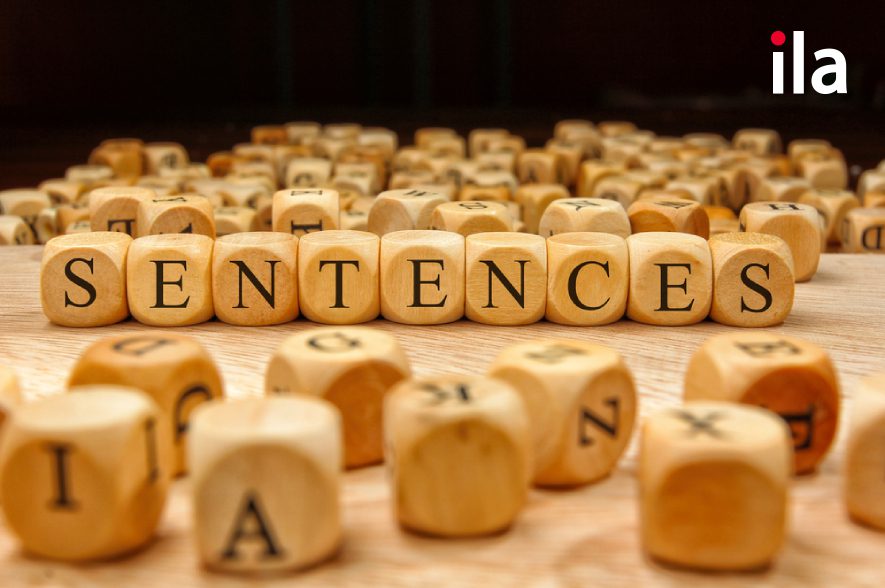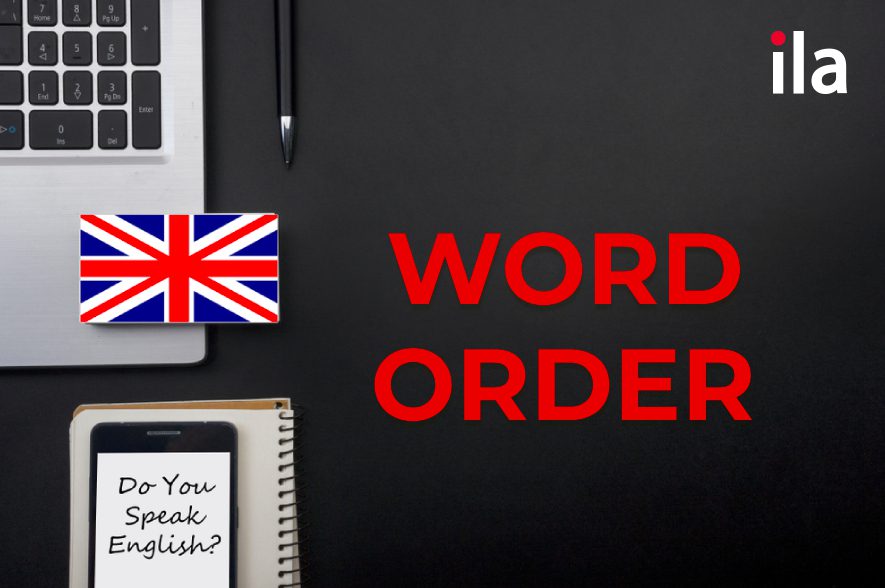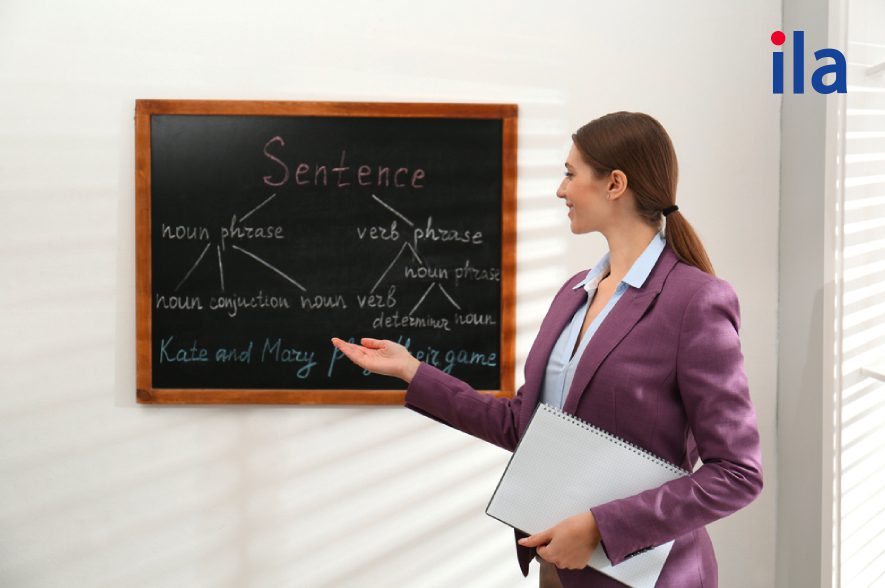How to Arrange Word Order in English Grammatically and Naturally? Let’s explore word order in English sentences and the order of adjectives with ILA to form correct sentences and communicate more confidently.
Guide to Arranging Word Order in English
Word order in English refers to the arrangement of words in a specific sequence to convey meaning and grammatical function within a sentence.
1. Arranging Words at the Phrase Level
a. Ordering Adjectives in English (OSASCOMP)
• O: Opinion
• S: Size
• A: Age
• S: Shape
• C: Color
• O: Origin
• M: Material
• P: Purpose
b. Arranging Adverbs in English
• Adverbs of manner: Placed after the verb or object.
• Adverbs of place: Placed after the verb or at the end of the clause.
• Adverbs of frequency: Placed before the main verb and after auxiliary verbs.
c. Ordering Words in English Phrasal Verbs
• Separable phrasal verbs: The object can be placed between or after the verb phrase.
• Inseparable phrasal verbs: The object cannot be placed between the verb and the particle.
2. Arranging Words at the Sentence Level
a. Word Order in English Declarative Sentences
• Subject + verb.
• Subject + verb + object.
• Subject + verb + complement.
b. Word Order in English Interrogative Sentences
• Yes/No questions: Auxiliary verb + subject + main verb?
• Wh-questions: Wh-word + auxiliary verb + subject + main verb?
c. Arranging Words in English Imperative Sentences
Imperative sentences usually consist of a verb alone or a verb combined with other elements.
d. Ordering Words in English Exclamatory Sentences
• What + (+ adjective) + noun!
• How + adjective + subject + be! or How + adverb + subject + verb!
What is Word Order in English?
Word order refers to the arrangement of words in a specific sequence in English sentences. Words are connected in a particular order not only to convey lexical meaning but also to express grammatical function.
The basic sentence structure in English is: S + V + O.
• S (Subject): The doer of the action.
• V (Verb): The action.
• O (Object): The receiver of the action.
Examples:
• I love you.
• I usually get up at 7 AM.
To write correct sentence structures, you first need to master the parts of speech and common sentence components in English.
Positions of Parts of Speech in English
In English, there are 8 parts of speech, including: noun, pronoun, verb, adverb, adjective, preposition, conjunction, and interjection. The positions of these parts of speech in English are as follows:
|
Part of Speech |
Function |
Example |
Example of Word Order in English |
|
Noun |
Names a person, thing, place, or idea |
Man, Butte College, house, happiness… |
Ella lives in France. |
|
Verb |
Describes an action or state |
Jump, write, become, is… |
I’ve already checked twice. |
|
Adjective |
Modifies or describes a noun or pronoun |
Pretty, old, blue, smart… |
The dog is bigger than the cat. |
|
Adverb |
Modifies or describes a verb, adjective, or another adverb |
Gently, extremely, carefully, well… |
Talia writes quite quickly. |
|
Preposition |
Placed before a noun or pronoun to form a phrase that modifies another word in the sentence |
By, with, about, until… |
I left the cup on the kitchen counter. |
|
Conjunction |
Connects words, phrases, or clauses |
And, but, or, while, because… |
Daria likes swimming and hiking. |
|
Interjection |
Expresses emotion |
Oh!, Wow!, Oops!… |
Ouch! I hurt my arm. |
|
Pronoun |
Replaces a noun |
She, we, they, it… |
I don’t really know her. |
|
Determiner |
Specifies a noun |
This, that, many… |
This chair is more comfortable than that one. |
Sentence Components in English Word Order
The basic components of a sentence include the subject and the predicate. Additionally, other elements influence the arrangement of words in an English sentence.
a. Subject
The subject of a sentence indicates who or what performs the action. It can be a noun, a noun phrase, or a pronoun, answering the questions “who?” or “what?”
Examples:
• Jamie is eating a pizza.
• The neighbour’s cat drank the milk.
• Mary and I went shopping for clothes.
b. Predicate
The predicate describes the action performed by the subject in the sentence. It can include an action verb or a linking verb.
Examples:
• I danced.
• The pilot flew the plane.
• They bought clothes and had lunch.
c. Object
The direct object (D.O.) and indirect object (I.O.) are nouns that describe who or what the action is directed toward.
Example:
• Lisa gave her sister a hug. (A hug is the direct object, while her sister is the indirect object.)
d. Complement
Complements add meaning to either the subject (subject complement) or the object (object complement). According to English word order, they are usually nouns, pronouns, phrases, or adjectives that follow a verb.
Examples:
• The girl is beautiful. (Beautiful is the subject complement for the girl.)
• They painted their house blue. (Blue is the object complement for their house.)
e. Modifier
Modifiers are optional sentence elements. Therefore, in many English word orders, this component may be absent. Modifiers are often adjectives or adverbs that describe the subject or predicate.
Examples:
• A big dog is barking.
• We walked slowly.
Word Order in English Phrases
Word order in English sentences is also classified by adjective phrases, adverbial phrases, and verb phrases.
1. Adjective Order in English (OSASCOMP)
When arranging word order in an English sentence, you may encounter multiple adjectives. To form correct adjective structures, follow the OSASCOMP order:
• Opinion (O): General or specific opinion
Examples: good, beautiful, precious, horrible, elegant, lovely…
• Size (S): Size or dimension
Examples: huge, tiny, big, medium-sized, small, long…
• Age (A): Age or time-related aspects
Examples: new, old, young, ancient, decades-old…
• Shape (S): Shape or form
Examples: square, round, geometric, spherical, circular…
• Colour (C): Color or shade
Examples: blue, crimson, violet, orange, silver…
• Origin (O): Nationality or origin
Examples: Vietnamese, African, Dutch, Spanish…
• Material (M): Material or substance
Examples: silk, acrylic, glass, wooden…
• Purpose (P): Function or intended use
Examples: denim (jacket), painting (brush), hunting (dog), pickup (truck)…
The correct adjective order should be followed, even if not all adjectives are used in a sentence.
Examples:
• Amanda was wearing a long green evening gown. (size – colour)
• He still drives that strange black plastic car around. (opinion – colour – material)
2. Adverb Order and the Position of Word Types in English
Different types of adverbs have different positions in English sentence structure.
a. Adverbs of Manner
Adverbs of manner usually come after the main verb or after the object.
Examples:
• She sings beautifully.
• She sings the song beautifully.
When there is a preposition before the object, the adverb of manner can be placed before the preposition, before the verb, or after the object.
Examples:
• He listened attentively to the story.
• He attentively listened to the story.
• He listened to the story attentively.
b. Adverbs of Place
Adverbs of place generally come after the main verb or at the end of the clause they modify.
Examples:
• He ran outside.
• He had run to his car outside before the house collapsed.
c. Adverbs of Frequency
Adverbs of frequency usually come before the main verb and after the auxiliary verb. If the main verb is to be, the adverb of frequency follows it.
Examples:
• Wendy always washes the dishes.
• They have rarely talked on the phone.
• Nick is usually late for meetings.
The adverbs occasionally, sometimes, often, frequently, usually can be placed at the beginning or end of a sentence.
Examples:
• Sometimes, the simplest things are the best.
• The simplest things are the best sometimes.
3. Word Order in Phrasal Verbs
Phrasal verbs are combinations of a verb with a preposition or an adverb to form a new phrase. Word order in English changes depending on the type of phrasal verb.
a. Separable Phrasal Verbs
For separable phrasal verbs, the direct object can be placed either between the verb and the particle or after the entire phrase.
Examples:
• She brought up three children.
• She brought three children up.
However, when the direct object is a pronoun, it must be placed between the verb and the particle.
Example:
• She brought them up. (Not: She brought up them.)
b. Non-separable Phrasal Verbs
For non-separable phrasal verbs, the direct object (if present) cannot be placed between the verb and the particle. However, most non-separable phrasal verbs are intransitive, meaning they do not take a direct object.
Examples:
• Maria ran into an old friend. (Not: Maria ran an old friend into.)
• His job is barely enough for him to get by.
Word Order in English Sentences at the Sentence Level
At the sentence level, word order in English also varies depending on the position of sentence components and the intended purpose of the sentence.
1. Declarative Sentences
A declarative sentence, also known as a statement, is a type of sentence used to provide information, express a fact, or state a universal truth. Below are common word orders found in English declarative sentences:
|
Word Order |
Example |
|
Subject + verb |
Daniel is running. |
|
Subject + verb + object |
She has drunk two cups of coffee. |
|
Subject + verb + complement |
That rice tastes quite sweet. |
Besides the affirmative form mentioned above, declarative sentences can also be in the negative form.
When using the negative form, you need to add an auxiliary verb + “not” before the main verb. If a declarative sentence is used as a question, the word order remains the same as in a regular declarative sentence.
Examples:
• Two plus two doesn’t make five.
• Anthony likes coffee?
2. Interrogative Sentences
An interrogative sentence is a sentence used to ask a question. The word order in English sentences varies depending on the type of question.
|
Question Type |
Word Order |
Example |
|
Yes-No Question |
Auxiliary verb + subject + main verb? |
Do you like romantic comedies? |
|
Wh-Question |
Wh-word + auxiliary verb + subject + main verb |
When does the movie start? |
3. Imperative Sentences
Imperative sentences are used to give commands, instructions, requests, or warnings about a particular action. Most imperative sentences do not have an explicit subject (the subject is implicitly understood as “you”). The word order in English imperative sentences is usually simple, consisting of a verb or a verb combined with other elements.
Examples:
• Run!
• Don’t move!
• Open the blue box.
Apart from starting an imperative sentence with a verb, some types of imperative sentences follow a special word order in English.
|
Type of Imperative Sentence |
Word Order |
Example |
|
Imperative with a Subject |
Subject + verb (bare infinitive) |
Somebody answer the phone! |
|
Emphatic Imperative |
Do + verb |
Do take a seat. |
|
Imperative with Always/Never/Ever |
Always/Never + verb Don’t + ever |
Always/Never follow him. Don’t ever speak to me like that. |
4. Exclamative Sentences
Exclamative sentences are used to express emotions or attitudes toward the subject being mentioned. The word order in exclamative sentences varies depending on whether the sentence follows the what structure or the how structure.
|
Type of Exclamative Sentence |
Word Order |
Example |
|
Exclamation with “What” |
What + (+ adjective) + noun |
What a (beautiful) day! |
|
Exclamation with “How” |
How + adjective + subject + be How + adverb + subject + verb |
How beautiful it is! How softly she spoke! |
Exercises on Word Order in English Sentences
Rewrite the sentences in the correct English word order:
1. always / at nine o’clock / out of the garage / in the morning / drives / his car / he
2. he / to town / after breakfast / often / Mrs. Hodges / takes
3. a parking place / near the shops / they / find / rarely
4. sometimes / in a garage / Mr. Hodges / his car / parks
5. fly / with my parents / to Florida / sometimes / I / in winter
6. late / came / last year / she / often / to school / in spring / the /of
7. often / have / at about three o’clock / a cup of tea / they / at the hotel / in the afternoon
8. meet / at the sports ground / they / after dinner / always / their friends
9. enjoys / very much / swimming / in our pool / always / in the morning / she
10. hardly / last year / could / ski / he
Answers:
1. He always drives his car out of the garage at nine o’clock in the morning.
2. He often takes Mrs. Hodges to town after breakfast.
3. They rarely find a parking place near the shops.
4. Mr. Hodges sometimes parks his car in a garage.
5. I sometimes fly with my parents to Florida in winter.
6. She often came late to school in the spring of last year.
7. They often have a cup of tea at the hotel at about three o’clock in the afternoon.
8. They always meet their friends at the sports ground after dinner.
9. She always enjoys swimming very much in our pool in the morning.
10. He could hardly ski last year.
Mastering word order in English sentences will help you convey messages naturally and accurately. Develop the habit of learning vocabulary while practicing sentence construction based on word position rules to improve your skills daily! Keep practicing!









